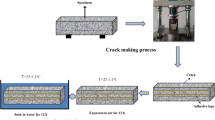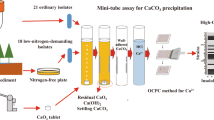Abstract
A strategy to supply molecular oxygen for microbial calcium precipitation was developed for the first time. Firstly, a controlled oxygen-releasing tablet (ORT) containing CaO2 and lactic acid with a suitable ratio of 9:1 was developed. It can provide a stable oxygen supply and maintain pH in the range of 9.5–11.0 for 45 days while contacting with water. In the presence of oxygen, a self-healing bacterium H4 spores germinated more effectively and maintained high metabolic activity. Furthermore, H4 vegetative cells induced 50 % more calcium precipitation than that obtained without oxygen supply. Finally, a binary self-healing system containing bacterial spores and ORT was established. The calcium precipitation experiments showed that H4 in the binary self-healing system precipitated 27.5 mM calcium with oxygen supply after 32 days and dissolved oxygen (DO) concentration of the solution decreased from 15 to 4 mg l−1, while only 6.9 mM calcium precipitation was obtained without oxygen supply. This work can disclose the effect of oxygen on microbial calcium precipitation and further lay a foundation for the establishment of ternary self-healing system containing bacteria, ORT, and nutrients, which will be promising for the self-healing of cracks deep inside the concrete structure.







Similar content being viewed by others
References
Achal V, Mukerjee A, Sudhakara Reddy M (2013) Biogenic treatment improves the durability and remediates the cracks of concrete structures. Constr Build Mater 48:1–5
Arienzo M (2000) Degradation of 2,4,6-trinitrotoluene in water and soil slurry utilizing a calcium peroxide compound. Chemosphere 40(4):331–337
De Muynck W, Cox K, Belie ND, Verstraete W (2008) Bacterial carbonate precipitation as an alternative surface treatment for concrete. Constr Build Mater 22(5):875–885
De Muynck W, De Belie N, Verstraete W (2010) Microbial carbonate precipitation in construction materials: a review. Ecol Eng 36(2):118–136
Ersan YC, Da Silva FB, Boon N, Verstraete W, De Belie N (2015) Screening of bacteria and concrete compatible protection materials. Constr Build Mater 88:196–203
Gollapudi UK, Knutson CL, Bang SS, Islam MR (1995) A new method for controlling leaching through permeable channels. Chemosphere 30(4):695–705
Herrera A, Gómez M, Packard TT, Reglero P, Blanco E, Barberá-Cebrián C (2014) Potential respiration estimated by electron transport system activity in deep-sea suprabenthic crustaceans off Balearic Islands (western Mediterranean). J Mar Syst 138:104–111
Jie Y, Kai LF, Lei Y, Yun HD (2014) A method for preparing the oxygen release compound and its study. J Saf Environ 14(2):117–123
Jonkers HM, Schlangen E Crack repair by concrete-immobilized bacteria. In: Proceedings of the First International Conference on Self Healing Materials, Noordwijk aae Zee, the Netherlands, 18–20 April 2007. Springer, p 7
Jonkers HM, Thijssen A, Muyzer G, Copuroglu O, Schlangen E (2010) Application of bacteria as self-healing agent for the development of sustainable concrete. Ecol Eng 36(2):230–235
Khodaveisi J, Banejad H, Afkhami A, Olyaie E, Lashgari S, Dashti R (2011) Synthesis of calcium peroxide nanoparticles as an innovative reagent for in situ chemical oxidation. J Hazard Mater 192(3):1437–1440
Li W, Chen WS, Zhou PP, Yu LJ (2013a) Influence of enzyme concentration on bio-sequestration of CO2 in carbonate form using bacterial carbonic anhydrase. Chem Eng J 232:149–156
Li W, Chen WS, Zhou PP, Zhu SL, Yu LJ (2013b) Influence of initial calcium ion concentration on the precipitation and crystal morphology of calcium carbonate induced by bacterial carbonic anhydrase. Chem Eng J 218:65–72
Lin CW, CH W, Tang CT, Chang SH (2012) Novel oxygen-releasing immobilized cell beads for bioremediation of BTEX-contaminated water. Bioresour Technol 124:45–51
Lyu YH, Zheng W, Zheng TL, Tian Y (2014) Biodegradation of polycyclic aromatic hydrocarbons by Novosphingobium pentaromativorans US6–1. PLoS One 9(7): doi: 10.1371/journal.pone.0101438
Pandey R, Ter Beek A, Vischer NOE, Smelt JPPM, Brul S, Manders EMM (2013) Live cell imaging of germination and outgrowth of individual Bacillus subtilis spores; the effect of heat stress quantitatively analyzed with SporeTracker. PLoS One 8(3): doi: 10.1371/journal.pone.0058972
Qian CX, Li RY, Pan QF, Luo M, Rong H (2013a) Microbial self-healing effects of concrete cracks. Journal of Southeast University (Natural Science Edition) 43(2):360–364
Qian CX, Luo M, Pan QF, Li RY (2013b) Mechanism of microbially induced calcite precipitation in self-healing concrete. J Chin Ceram Soc 41(5):620–626
Ramakrishnan V Performance characteristics of bacterial concrete—a smart biomaterial. In: Proceedings of the First International Conference on Recent Advances in Concrete Technology, 2007. p 67–78
Santhanam M (2013) Magnesium attack of cementitious materials in marine environments. In: Alexander M, Bertron A, De Belie N (eds) Performance of cement-based materials in aggressive aqueous environments: state-of-the-art report, RILEM TC 211-PAE. Springer, Dordrecht, pp. 75–90
Santhosh K, Ramachandran VR, Sookie SB (2001) Remediation of concrete using microorganisms. ACI Mater J 98(1):3–9
Sarayu K, Iyer NR, Murthy AR (2014) Exploration on the biotechnological aspect of the ureolytic bacteria for the production of the cementitious materials—a review. Appl Biochem Biotechnol 172(5):2308–2323
Sierra-Beltran MG, Jonkers HM, Schlangen E Performance of SHCC with bacteria for concrete patch repair. In: Proceedings of the structural faults and repair conference, London, UK, 8–10 July 2014
Van Tittelboom K, De Belie N (2013) Self-healing in cementitious materials—a review. Materials 6(6):2182–2217
Wang JY, Belie N, Verstraete W (2011) Diatomaceous earth as a protective vehicle for bacteria applied for self-healing concrete. J Ind Microbiol Biotechnol 39(4):567–577
Wang JY, Dewanckele J, Cnudde V, Van Vlierberghe S, Verstraete W, De Belie N (2014a) X-ray computed tomography proof of bacterial-based self-healing in concrete. Cem Concr Compos 53:289–304
Wang JY, Soens H, Verstraete W, De Belie N (2014b) Self-healing concrete by use of microencapsulated bacterial spores. Cem Concr Res 56:139–152
Wang JY, Van Tittelboom K, De Belie N, Verstraete W (2012) Use of silica gel or polyurethane immobilized bacteria for self-healing concrete. Constr Build Mater 26(1):532–540
Wiktor V, Jonkers HM (2011) Quantification of crack-healing in novel bacteria-based self-healing concrete. Cem Concr Compos 33(7):763–770
Wolanov Y, Prikhodchenko PV, Medvedev AG, Pedahzur R, Lev O (2013) Zinc dioxide nanoparticulates: a hydrogen peroxide source at moderate pH. Environ Sci Technol 47(15):8769–8774
Wu M, Johannesson B, Geiker M (2012) A review: self-healing in cementitious materials and engineered cementitious composite as a self-healing material. Constr Build Mater 28(1):571–583
Xing F, Ni Z, Han N, Dong B, Du X, Huang Z, Zhang M Self-healing mechanism of a novel cementitious composite using microcapsules. In: Proceedings of the International Conference on Durability of Concrete Structures, Hangzhou, China, 2008. vol 2627
Xu J, Yao W, Jiang Z (2013) Non-ureolytic bacterial carbonate precipitation as a surface treatment strategy on cementitious materials. J Mater Civ Eng 26(5):983–991
Zhang JL, RS W, Li YM, Zhong JY, Deng X, Liu B, Han NX, Xing F (2016) Screening of bacteria for self-healing of concrete cracks and optimization of the microbial calcium precipitation process. Appl Microbiol Biotechnol. doi:10.1007/s00253-016-7382-2
Acknowledgments
The authors acknowledge the financial support provided by National Natural Science Foundation of China (No. 51120185002, No. 51578339).
Author information
Authors and Affiliations
Corresponding authors
Ethics declarations
Conflict of interest
The authors declare that they have no conflict of interest.
Human and animal rights and informed consent
This article does not contain any studies with human participants or animals performed by any of the authors.
Rights and permissions
About this article
Cite this article
Zhang, J.L., Wang, C.G., Wang, Q.L. et al. A binary concrete crack self-healing system containing oxygen-releasing tablet and bacteria and its Ca2+-precipitation performance. Appl Microbiol Biotechnol 100, 10295–10306 (2016). https://doi.org/10.1007/s00253-016-7741-z
Received:
Revised:
Accepted:
Published:
Issue Date:
DOI: https://doi.org/10.1007/s00253-016-7741-z




